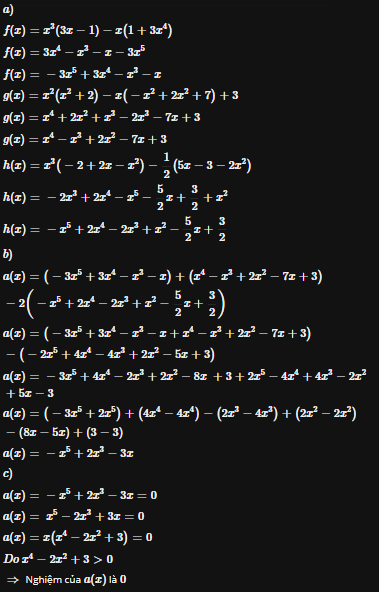Hãy nhập câu hỏi của bạn vào đây, nếu là tài khoản VIP, bạn sẽ được ưu tiên trả lời.

\(a.\)\(x^2+3x=0\)
\(\Leftrightarrow x\left(x+3\right)=0\)
\(\Leftrightarrow\orbr{\begin{cases}x=0\\x+3=0\end{cases}}\Leftrightarrow\orbr{\begin{cases}x=0\\x=-3\end{cases}}\)
\(b.\)\(5x^3-4x=0\)
\(\Leftrightarrow x\left(5x^2-4\right)=0\)
\(c.\)\(\left(x+2\right)\left(7-4x\right)=0\)
\(\Leftrightarrow\orbr{\begin{cases}x+2=0\\7-4x=0\end{cases}\Leftrightarrow\orbr{\begin{cases}x=-2\\x=-\frac{7}{4}\end{cases}}}\)
\(d.\)\(2x\left(x+1\right)-x-1=0\)
\(\Leftrightarrow2x\left(x+1\right)-\left(x+1\right)=0\)
\(\Leftrightarrow\left(x+1\right)\left(2x-1\right)=0\)
\(\Leftrightarrow\orbr{\begin{cases}x+1=0\\2x-1=0\end{cases}\Leftrightarrow\orbr{\begin{cases}x=-1\\x=\frac{1}{2}\end{cases}}}\)

a) Đặt A(x)=0
\(\Leftrightarrow4x-1=0\)
\(\Leftrightarrow4x=1\)
hay \(x=\dfrac{1}{4}\)
b) Đặt B(x)=0
\(\Leftrightarrow2x^2-8=0\)
\(\Leftrightarrow2x^2=8\)
\(\Leftrightarrow x^2=4\)
hay \(x\in\left\{2;-2\right\}\)

Chiều rộng là : 15 : ( 5 - 3 ) x 3 = 22,5 m
Chiều dài là : 15 + 22,5 = 37,5 m
Chu vi là : ( 37,5 + 22,5 ) x 2 = 120 m
Diện tích là : 37,5 x 22,5 = 843,75 m2

Lời giải:
a)
$f(x)=3x^3+4x^2-2x-1-2x^3=(3x^3-2x^3)+4x^2-2x-1=x^3+4x^2-2x-1$
b)
$h(x)=f(x)-g(x)=(x^3+4x^2-2x-1)-(x^3+4x^2+3x-2)$
$=(x^3-x^3)+(4x^2-4x^2)-(2x+3x)-1+2=1-5x$
c)
$h(x)=0\Leftrightarrow 1-5x=0\Leftrightarrow x=\frac{1}{5}$
Vậy $x=\frac{1}{5}$ là nghiệm của $h(x)$
 nha
nha 

a)Đặt A (x) = 0
hay \(3x-6=0\)
\(3x\) \(=6\)
\(x\) \(=6:3\)
\(x\) \(=2\)
Vậy \(x=2\) là nghiệm của A (x)
b) Đặt B (x) = 0
hay \(2x-10=0\)
\(2x\) \(=10\)
\(x\) \(=10:2\)
\(x\) \(=5\)
Vậy \(x=5\) là nghiệm của B (x)
c) Đặt C (x) = 0
hay \(x^2-1=0\)
\(x^2\) \(=1\)
\(x^2\) \(=1:1\)
\(x^2\) \(=1\)
\(x\) \(=\overset{+}{-}1\)
Vậy \(x=1;x=-1\) là nghiệm của C (x)
d) Đặt D (x) = 0
hay \(\left(x-2\right).\left(x+3\right)=0\)
⇒ \(x-2=0\) hoặc \(x+3=0\)
* \(x-2=0\) * \(x+3=0\)
\(x\) \(=0+2\) \(x\) \(=0-3\)
\(x\) \(=2\) \(x\) \(=-3\)
Vậy \(x=2\) hoặc \(x=-3\) là nghiệm của D (x)
e) Đặt E (x) = 0
hay \(x^2-2x=0\)
⇔\(\left[{}\begin{matrix}x^2-2x\\\left(x-2\right)x\end{matrix}\right.\)
⇒\(\left(x-2\right)x\)
⇔ \(x.\left(2x-1\right)=0\)
⇔ \(\left[{}\begin{matrix}x=0\\2x-1=0\end{matrix}\right.\)
\(\left\{{}\begin{matrix}x=0\\x=2\end{matrix}\right.\)
Vậy \(x=0\) hoặc \(x=2\) là nghiệm của E (x)
f) Đặt F (x) = 0
hay \(\left(x^2\right)+2=0\)
\(x^2\) \(=0-2\)
\(x^2\) \(=-2\)
\(x\) \(=\overset{-}{+}-2\)
Do \(\overset{+}{-}-2\) không bằng 0 nên F (x) không có nghiệm
Vậy đa thức F (x) không có nghiệm
g) Đặt G (x) = 0
hay \(x^3-4x=0\)
⇔\(\left[{}\begin{matrix}x^3-4x\\\left(x-4\right)x^2\end{matrix}\right.\)
⇒ \(\left(x-4\right)x^2=0\)
⇔ \(x.\left(4x-1\right)=0\)
⇔\(\left[{}\begin{matrix}x=0\\4x-1=0\end{matrix}\right.\)
\(\left\{{}\begin{matrix}x=0\\x=\dfrac{1}{4}\end{matrix}\right.\)
Vậy \(x=0\) hoặc \(x=\dfrac{1}{4}\) là nghiệm của G (x)
h) Đặt H (x) = 0
hay \(3-2x=0\)
\(2x\) \(=3+0\)
\(2x\) \(=3\)
\(x\) \(=3:2\)
\(x\) \(=\dfrac{3}{2}\)
Vậy \(x=\dfrac{3}{2}\) là nghiệm của H (x)
CÂU G) MIK KHÔNG BIẾT CÓ 2 NGHIỆM HAY LÀ 3 NGHIỆM NỮA